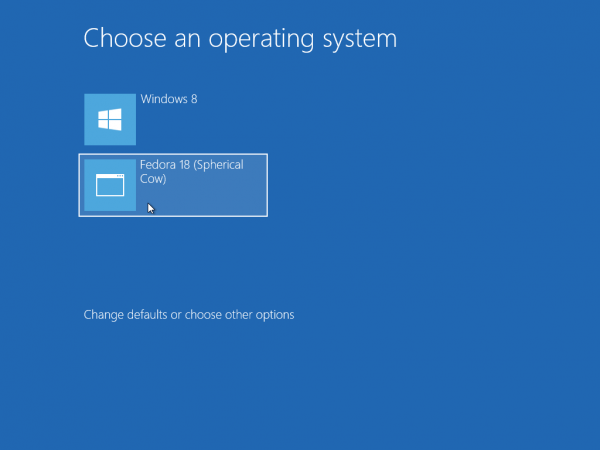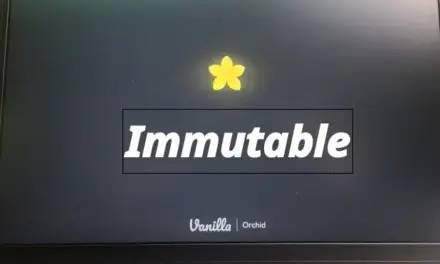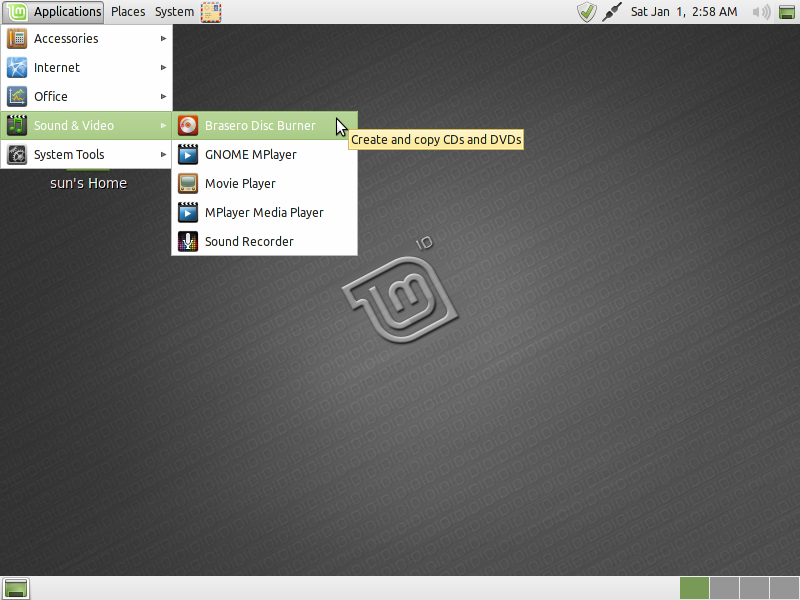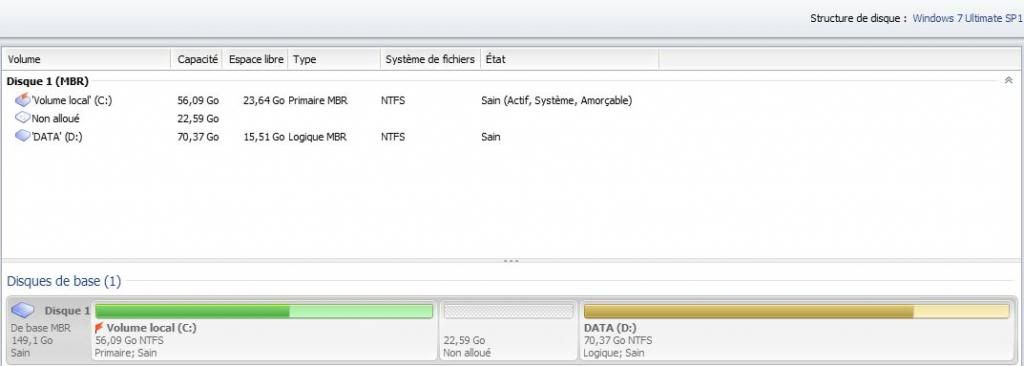6. Create Partitions for Fedora 18: There are two ways to go about creating partitions for Fedora 18. You can let the installer do it automatically or do it yourself, that is, manually. For this installation, I chose to let Anaconda do the dirty job. Note that the default disk partitioning scheme in Fedora 18 is LVM. And the new Anaconda, like the old Anaconda, will create a standard partition for /boot, and LVM partitions for /, /home, and Swap. Click “Click here to create them automatically.”

This screen shot shows the partitions for Fedora 18. Click Apply Changes, then on Finish Partitioning.

7. Install Software: Back to the hub. Click on Begin Installation.

8. Set Root’s Password: With software installation taking place, take a minute or two to set the password for the root account.

Yep, you can get away with a 1-character password for root. That’s not recommended, but I did it just to show that the installer allows it.

9. GRUB 2 Boot Menu: After installation has completed successfully, rebooting the computer will bring up GRUB’s boot menu. As I wrote earlier, this is because Anaconda installs GRUB 2 in the MBR, overwriting Windows 8’s boot program. If you are happy with this, the tutorial ends here. Else, the next task is to boot into your new Fedora 18 installation and install GRUB 2 in the first sector of the boot partition, also called the Partition Boot Record (PBR).

10. Install GRUB 2 in the Boot Partition: Once in Fedora, launch a shell terminal and su to root. To install GRUB 2 in the boot partition’s PBR, you need to know its partition number or device name. The output of df -h will reveal that information. On my installation, it is /dev/sda3. Next, type grub2-install /dev/sda3. The system will complain and refuse to do as instructed. Not to worry, you can force it.

To compel it to install GRUB 2 where we want, type add “- -force” option to the command, so that it reads grub2-install – -force /dev/sda3. Once that’s done, reboot the computer.

11. Install EasyBCD: When the computer reboots, you will still see Fedora’s boot menu, but instead of booting into Fedora 18, boot into Windows 8. The next task is to restore its boot program to the MBR and add an entry for Fedora 18 in its boot manager’s menu. The program I know that makes it easy to do that, is EasyBCD. Download it from here. Note that EasyBCD is free for personal use. After installing it, start it, if it does not start automatically. Shown below is its main window. Click on Add New Entry to begin.

Then click on the Linux/BSD tab. Select GRUB 2 from the Type dropdown menu, and edit the Name field to match. Click on Add Entry.

This is a preview of what the entries will be on the boot menu of Windows 8. The final task is to restore the Windows 8 boot program to the MBR. To do that, click on BCD Deployment.

12. Restore Windows 8/s Boot Program to MBR: Under MBR Configuration Options, make sure that the first option is selected. Then click on Write MBR. Exit EasyBCD and reboot the computer. Test to make sure that you can boot into either OS. Enjoy!









Hi I followed your steps was trying it on fedora 20 the problem is i’ve reached upto installing grub2 in the boot partition but I can’t boot into windows as you specificed that there is no boot record so how should I boot into windows?
With Fedora 20, I think thinks are a bit easier. After installation, there should be an entry for the Windows boot manager in the GRUB menu, whether you partitioned the Fedora end manually or used the automatic partitioning option.
Can you at least boot into Fedora?
Is there some like EASYBCD for FEDORA 20?
Is there some explanation as https://neosmart.net/wiki/easybcd/dual-boot/linux/fedora/ for FEDORA 20???
Yet to be published, but I’ll get it done in a week.
Hi,
I’ve followed the process. At the end after rebooting it is still booting in to Fedora not windows so I cant proceeed further.
Pl reply wit help
The new anaconda is certainly no improvement; technically yes but setting ip a Win8 dual boot was breathtaking…
Not that I like Win8 but it was’t my laptop you see. Thanks for the help provided here!
When i was installing fedora 18, at the last of the installation phase it shows the error “boot loader installation failed.”
this is my Acer Aspire V3-571 free dos laptop running windows 8 in one partition.
I googled and found to disable the “secure boot” in UEFI..but in my pc i could’t find UEFI setting like that in advance options.
kindly help me to solve this problem
I think it is required that users should be able to disable UEFI on a Windows 8 machine. If you are not able to, you might want to call Acer’s tech support and complain. If they intentionally left out that option, returning the unit to them and telling them why will send the right message.
This very good article 🙂 .
Maybe in next time I hope can read Article “How to Dual-boot Fedora 18 (RAID 0)& WIndows 7/8 (RAID 0).
With that much sarcasm, perhaps you should write one yourself.
Thanks for this tutorial!
I’ve installed fedora 18 but I am not an MBR partition table but the GPT is the same as the above is different please help me
Could you explain what you want help with in a little bit more detail?
I install dual boot windows 8 pro with fedora 18 and my hard drive is GPT type. after Fedora 18 installation process restart my computer later emerged grub 2 fedora 18 and fedora 18 straight into no option to boot into Windows 8 and How did the solution in grub 2 is not no option to boot into Windows 8
Hey do u think its possible to do the same except with ubuntu 11.10 or the newest one? If so u think u can help us with a tutorial on how to do it? thanks man your site is awesome.
Hi, does it work with windows 8 pre-installed (x64 normal version) ?
It should.
Ok thx, i’ll try.
I tried to install Fedora 18 but i have a problem when i reboot, i get directly into the UEFI without being able to do anything else and I have nothing in the “Boot Options Priorities”. Reseting settings doesn’t help and my usb key with W8 recovery either, I’m a little desperate do you have an idea to fix it ? thx
Shrinking is supposed to be possible from the ‘reclaim space’ screen, but we had to take it out of f18 late in the cycle due to a bug. it will be back in f19. As you wrote, in f18 you need to go through custom partitioning to shrink.
you do actually have a choice with the bootloader; you can choose not to install one at all. may be slightly better for your purposes, or not. That’s on the ‘full disk summary and options’ screen.
Thx a lot for that tuto but new installer is annoying i went to install it side by side with windows 7 i couldn’t complete installation i already make free space for fedora 18 but i didn’t know how to use it ? any help ?
Post the partitioning scheme here. That is number of partitions and their sizes. Primary or logical?
ok that picture defines everything

and i don’t want to install Grub in MBR and F18 don’t leave you any choice
(Sorry for my English it’s not my primary language )
I just wish people will stop apologizing for their English.
Anyway, so there are 3 partitions – C, D, and free space (unallocated). Since D and the free space are the possible candidates for installing F18, which one do you want to do?
By the way, where is your system partition?
system partition in “C” and i want to install F18 in free space, if i do it like this tuto is the result will be the same (with windows 7) ?
hello again i completed installation and i did all the steps only problem is when windows boot loader come and i choose fedora it load to me some terminal ” Grub> ” and i didn’t know what i type to enter to fedora ?
Oh shit i feel so stupid right now lol, i fix everything the problem is i used an older version of EasyBCD ( 2.1 not 2.2) so in step when i select GRUB 2 from the Type dropdown menu the “automatically locate and load” wasn’t available in version 2.1 so shit happened when i upgrade my easyBCD i choose partition where grub2 installed and everything work just fine thx a lot for this tuto it really helped me and sorry for the annoying lol .
thank you…the new installer is such a down grade from the old one..but now i understand it better..thanks again !